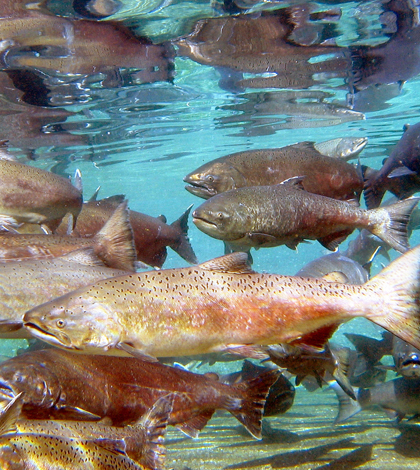Timing of one of Columbia River’s most productive Chinook salmon run modeled

Chinook salmon (Credit: Pacific Northwest National Laboratory)
In the Columbia River Basin, where just a sliver remains of the millions of salmon that once swam upstream from the ocean for annual spawning runs, one free-flowing section of the river harbors an encouragingly vigorous population of Chinook salmon.
This “Upriver Bright” stock, which spawns in the Hanford Reach of the Columbia, is one of the few Chinook salmon stocks in the river that supports strong commercial, sport and tribal fisheries.
Scientists and resource managers are trying to keep it that way. Part of that effort includes a recent modeling initiative into the timing of the flip of the switch in the salmon’s heads that tells them to head upstream and start building their nests, or redds. The resulting model will help scientists understand the fish’s ecology and evolution while giving dam managers a tool to mitigate disruptions to spawning grounds.
The model is based on more than 50 years of redd data from aerial surveys carried out by the U.S. Department of Energy’s Pacific Northwest National Laboratory. It compares daily redd numbers to the day of the year, as well as daily water temperature and discharge at the Priest Rapids Dam, a hydropower facility that marks the upper boundary of the Hanford reach.
Operations at the dam cause relatively large day-to-day fluctuations in flow levels, said Brian Bellgraph, fisheries scientist at the national laboratory and co-author on a recent paper describing the redd timing model. Scientists at the lab are looking for a clearer picture of the relationship between those fluctuations and the productivity of the salmon population downstream.
“One of the things that we had to understand as part of that was the timing of adult redd construction so we could find out where and when the redds are built and use the model to understand how flow fluctuations affect those locations and ultimately how many juvenile salmon were produced from them,” he said.

An aerial photo of Chinook salmon redds in the Hanford Reach of the Columbia River (Credit: Robert Muller)
Past statistical treatments of spawning run timing have largely focused on averages, said Daniel Hayes, professor of fisheries and wildlife at Michigan State University and lead author of the paper. Scientists determine a mean date of arrival to the spawning grounds or the date of peak redd construction. To get a sense of the environmental cues that triggered their arrival, scientists might compare that date with monthly, seasonal or annual temperature averages.
But reducing the spawning runs down to one day and matching it to a single water temperature polishes out the variability in salmon behavior that could be important to understanding how the might respond to long-term changes in their environment.
“Not every fish spawns the same day,” Hayes said. “There is a a lot of variability in that, which in the end is the raw material for evolution and adaptation to take place. If every fish did the same thing on the same day, there’s not much room for evolution.”
To capture that variability, the researchers turned to a dynamic model that better defines the window of time when salmon build redds rather than describing it with a single number. That allows for a quantification of those situations where the temperature isn’t quite right, but it’s close enough to warrant a 10 percent probability that a fish that hasn’t yet headed upstream will start its journey.
The redd construction timing model is one component of a larger tool for resource managers to predict the relative outcomes of different dam protocols, but the development also provides a look back at the past 50 years to see which parameters appear to have the most influence on that activity, as well as how things have changed.

The Priest Rapids Dam at the upper end of the Hanford Reach controls flows there, potentially impacting Chinook salmon redds (Credit: National Oceanic and Atmospheric Administration, via Wikimedia Commons)
Day of the year–which is a useful surrogate for environmental factors like the length of the daylight–is the strongest predictor of redd construction timing, followed by temperature, Hayes said.
The model also shows that redd construction is occurring later in the year than it did 50 years ago. That’s likely a result of rising water temperatures, not the day of the year.
“Day lengths haven’t changed,” Hayes said. “We haven’t screwed that up yet.”
Simulated estimates suggest that water temperatures at the Priest Rapids Dam on October 1 have risen nearly 2 degrees Celsius since 1950, perhaps as result of climate change or dam operations. The fish wait longer for water to cool down enough to trigger the spawning run. That’s potentially worrisome, Hayes said, because salmon have evolved to spawn under a particular set of environmental characteristics that give their offspring the best chance to survive which they hatch months later.
“Potentially, humanity, over time, has shifted the thermal characteristic of the river, inducing the fish to spawn later,” Hayes said. “If they spawn later, potentially, that means the young are hatching later in the spring, so we may be causing some mismatch of the hatch time.”
That could be the case in the short term, anyway. In the long term, those 10 percentile fish that are willing to start building redds when the temperature isn’t quite right could provide the variability needed to the species to evolve and adapt.
“It should develop new response temperature that’s more leading them to hatch at the right time of year,” Hayes said.
The details of the model were published in the online edition of the journal River Research and Applications.
Top image: Chinook salmon (Credit: Pacific Northwest National Laboratory, via Flickr)




Pingback: FishSens Magazine | NOAA Research Links River Flow with Changes in Chinook populations - FishSens Magazine